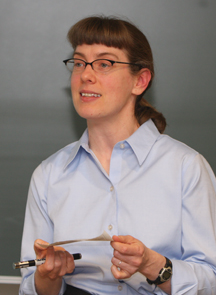Meeting the world’s long-term energy needs won’t necessarily require brilliant science, according to Dr. Sarah Keller of the University of Washington. Keller, the 2008 Haines Lecturer in Biochemistry, told a lunchtime crowd that the decisions that will have to be made with regard to energy sources are much more difficult.
 In preparing for the talk, Keller said, "I really just wanted to know what we could learn using only freshman chemistry and physics."
In preparing for the talk, Keller said, "I really just wanted to know what we could learn using only freshman chemistry and physics."
Keller used the session to demonstrate how even rudimentary understanding of chemistry and physics can provide scholars enough math and science to determine how much energy will be required and how much can be produced using a range of sources.
Professor Keller's scholarship is groundbreaking in the area of membrane organization and understanding how cell signaling occurs at the molecular level. In addition to receiving numerous awards and grants for her research she also received in 2006 the award for outstanding teaching at the University of Washington.
While at Wabash, she discussed the work of her research lab, "Seeing Spots: Liquid Domains in Lipid Membranes," and a lunch talk entitled "Using Freshman Chemistry to Understand 21st Century Energy Problems."
In the latter talk, she began with two basic premises: That energy consumption is increasing with the human population and there is a need to plan where future energy will come from, and that "we can go a long way [planning for the future] with just a rudimentary understanding of chemistry and physics."
Keller used a hot water shower as an example then guided the students, faculty, and staff through basic science to determine how much energy would be required to heat the water for an eight-minute shower. She went through the standard coal-burning process, as well as hydroelectric, geothermal, nuclear, solar, and biofuels.
Each energy source has pros and cons, she said, citing draught conditions that had an impact on dam-generated hydroelectric power in her hometown of Seattle. In 2003, the European heat wave led to an energy shortage since heat generated in energy production couldn’t be cooled in already hot rivers and streams. The ultimate result, she said, was a rash of human casualties.
Nuclear power seems to be a possible solution, she explained, but quickly noted that if the United States expands its nuclear energy sources as planned, it must similarly plan for a more efficient way to deal with nuclear waste. Even in France, where nuclear waste reprocessing is conducted, the end result — plutonium production — creates all-new problems.
She also noted recent efforts in Germany to drill down into the earth five kilometers to harness heat in order to heat water to generate electricity. The experiment involves drilling two five-kilometer holes and forcing water down one and out the other. How much energy it will take to force the water through the path has not been determined.
Keller touched briefly on solar energy, noting first that solar energy is only 10-20 percent efficient in generating electricity. Solar-thermal energy production is more efficient, depending on the season and geography. "China heats 80 percent of its hot water using solar power," she said.
"The point I’m trying to make is that you [students] already know how to do the calculations on your own," said Keller. "The decisions we will have to make [planning for our future] are hard. I just hope the equations will not hinder you from being involved in the decision making."
The Haines Lecture in Biochemistry is sponsored by the William J. and Wilma M. Haines Fund for the Study of Biochemistry. The fund is endowed by Dr. William J. Haines '40 and his late wife Wilma M. "Shorty" Haines.